
AF Nikkor
ED 14mm
f
/
2.8D
NIKON CORPORATION
Printed in Japan TT5C10 (80) 7MAA7180-10
使用説明書の内容が破損などによって判読できなくなったときは、ニコンサービスセンターにて新しい使用説明書をお求めください(有料)。
No reproduction in any form of this manual, in whole or in part (except for brief
quotation in critical articles or reviews), may be made without written authorization from
NIKON CORPORATION.
使用説明書
User’s Manual
Benutzerhandbuch
Manuel d’utilisation
Manual del usuario
Manuale d’uso
English Deutsch Français
1
絞り指標/着脱指標
Aperture index/Mounting index
Blendenindex/Objektivindex
Index d'ouverture/index de montage
Indice de aberturas/índice de monturas
2
絞りリング
Aperture ring
Blendenring
Bague des ouvertures
Anillo de aberturas
3
露出計連動ガイド
Meter coupling ridge
Steuerkurve
Index de couplage du posemètre
Protuberancia de acoplamiento al
exposímetro
4
CPU信号接点
CPU contacts
CPU-Kontakte
Contacts CPU
Contactos CPU
5
開放F値連動ガイド
Aperture indexing post
Anschlag für Blendenkupplung
Douille d'indexation d'ouverture
Poste de índice de apertura
6
フィルター枠
Filter holder
Filterhalter
Porte-filtre
Soporte del filtro
Ck
Ch
7
ファインダー内直読用絞り目盛
Aperture-direct-readout
scale
Skala für Blendendirekteinspiegelung
Echelle de lecture directe de l'ouverture
Escala de lectura directa de apertura
8
最小絞り信号ガイド(EE連動ガイド)
Minimum aperture signal post
(EE servo coupling post)
Signalstift für kleinste Blende
(Kupplungsstift für automatische
Blendensteuerung)
Levier de signal d'ouverture minimale
(levier de servo couplage EE)
Borne de señal de abertura mínima
(Borne de acoplador EE)
9
絞り目盛
Aperture scale
Blendenskala
Echelle des ouvertures
Escala de apertura
!
最小絞りロックレバー
Minimum aperture lock lever
Verriegelung für kleinste Blende
Levier de verrouillage d'ouverture
minimale
Palanca de fijación de apertura mínima
"
フォーカスモード切り換えリング
Focus mode select ring
Fokussierbetriebsarten-Wahlring
Bague de sélection de mode de mise au
point
Anillo selector de modo de enfoque Ck
Ch
#
フォーカスモード解除ボタン
Focus mode release button
Fokussierbetriebsarten-
Entriegelungsknopf
Bouton de libération du mode de mise
au point
Botón de liberación de modo de
enfoque
$
フード
Lens hood
Gegenlichtblende
Parasoleil
Visera del objetivo
%
フォーカスリング
Focus ring
Entfernungseinstellring
Bague de mise au point
Anillo de enfoque
&
距離目盛
Distance scale
Entfernungsskala
Echelle de distance
Escala de distancias
(
赤外指標
Infrared compensation index
Infrarot-Kompensationsindex
Repère de mise au point en infrarouge
Indicador de enfoque infrarrojo
)
距離目盛基準線
Distance index line
Entfernungs-Indexlinie
Ligne de repère des distances
Línea indicadora de distancia
~
被写界深度目盛
Depth-of-field indicators
Schärfentiefenskala
Echelle de profondeur de champ
Escala de profundidades de campoCk
Ch
図A 最小絞りロックレバー
Fig. A Minimum aperture lock lever
Abb. A Verriegelung für kleinsten Blende
Fig. A Levier de verrouillage d'ouverture minimale
Fig. A Palanca de bloqueo de apertura mínima
Ck
Ch
You are proud owner of the AF Nikkor ED 14mm f/2.8D, a lens that will provide
you with years of exciting picture-taking opportunities. Before using this lens,
please read these instructions and the notes on safety operations in your camera’s
user’s manual. Also, keep this manual handy for future reference.
Major features
•Autofocus operation is possible with Nikon autofocus cameras (except the F3AF and cameras with
lens mounts that do not have AF coupling); manual focus possible with all Nikon SLRs.
•Closest focus distance of 0.2m (0.7 ft) (from focal plane). The use of two aspherical and one ED
(extra-low dispersion) lens elements ensure excellent optical performance.
•This is a super wideangle lens, suitable for taking pictures of large buildings, indoor subjects,
snapshots, as well as landscapes and travel photography. Because this lens offers an extremely
exaggerated perspective combined with a wide maximum aperture, it is particularly effective for
shooting evening and night scenes or for “special-effect” pictures.
•For more accurate exposure control, subject distance information is transmitted from the lens to the
camera body, providing 3D Matrix Metering and 3D Multi-Sensor Balanced Fill-Flash with
appropriate Nikon cameras and Speedlights.
Important!
•Be careful not to soil or damage the CPU contacts.
•Do not attach the following accessories to this lens, as they might damage the CPU contacts: Auto
Extension Ring PK-1, PK-11 (use PK-11A), Auto Ring BR-4 (use BR-6 with BR-2A) and K1 Ring.
Other accessories may not be suitable when this lens is used with certain camera bodies. For
details, refer to user’s manual for each product.
•This lens is not compatible when used with a Nikon F3AF camera with the AF Finder DX-1 attached.
•Using this lens with cameras having built-in flash is not recommended, because vignetting occurs
due to the size of the lens itself and its large angle of view.
Focusing and depth of field
•The focus mode can be selected on the lens only if the camera’s focus mode is set to AF
(autofocus). Rotate the focus mode select ring on the lens to align the “
▲” mark with A (autofocus)
or M (manual focus) while pressing the focus mode release button.
•If your camera has a depth of field preview (stop-down) button or lever, depth of field can be
observed while looking through the camera viewfinder.
It is also possible to determine the depth of field by using the depth-of-field table.
Getting good results with autofocus
Refer to “Notes on using wide or super-wide angle AF Nikkor lenses” on the back of this sheet.
Recommended focusing screens
Various interchangeable focusing screens are available for certain Nikon SLR cameras to suit any
picture-taking situation. The ones recommended for use with this lens are:
◎:Excellent focusing
△:Acceptable focusing
The in-focus image in the central spot may prove to be slightly out of focus on film. Focus on
the surrounding matte area.
―:Not available.
(): Indicates degree of exposure compensation needed (Center-Weighted metering only). For F6
cameras, compensate by selecting “Other screen” in Custom Setting “b6: Screen comp.” and
setting the EV level to -2.0 to +2.0 in 0.5 EV steps. When using screens other than type B or E,
“Other screen” must be selected even when the required compensation value is “0” (no
compensation required). For F5 cameras, compensate using Custom Setting #18 on the camera
body. For F4-Series cameras, compensate using the Exposure Compensation Dial for the focusing
screen.
See user’s manual of the camera body for more details.
Blank box means not applicable. Since type M screen can be used for both macrophotography at a
1:1 magnification ratio and for photomicrography, it has different applications than other screens.
• When using the B/B2/B3, E/E2/E3, and K/K2/K3 focusing screens in cameras other than those
listed above, refer to the columns on the F4 + DP-20’s B, E and K screens, respectively.
Minimum aperture lock (Fig. A)
For programmed auto or shutter-priority auto exposure shooting (or for cameras capable of setting
the aperture on the camera), use the minimum aperture lock lever to lock the lens aperture at f/22.
1. Set the lens to its minimum aperture (f/22) by aligning it with the aperture index.
2. Slide the lock lever toward the aperture ring, so the two orange dots are aligned.
To release the lock, slide the lever in the opposite direction.
Filters (Fig. B)
A filter cannot be attached to the front of the lens. Use a sheet filter such as gelatin filter by cutting it
to an appropriate size as shown in Fig. B. Then insert it into the filter holder 6.
Lens care
•To remove dirt and smudges, use a soft, clean cotton cloth or lens tissue moistened with ethanol
(alcohol) or lens cleaner. Wipe in a circular motion from center to outer edge, taking care not to
leave traces or touch other parts.
•Never use thinner or benzene to clean the lens as this might damage the lens, result in a fire, or
cause health problems.
•When the lens will not be used for a long time, store it in a cool, dry place to prevent mold. Also
store the lens away from direct sunlight or chemicals such as camphor or naphthalene.
•Do not get water on the lens or drop it in water as this will cause it to rust and malfunction.
•Reinforced plastic is used for some parts of the lens. To avoid damage, never leave the lens in an
excessively hot place.
Standard accessories
•Leather front lens cover • Rear lens cap • Flexible lens pouch CL-S2
Specifications
Type of lens: D-type AF Nikkor super wideangle lens having built-in CPU and
Nikon bayonet mount
Focal length; 14mm
Maximum aperture: f/2.8
Lens construction: 14 elements in 12 groups (2 compound aspherical and 1 ED lens
elements)
Picture angle: 114° [90° with Nikon digital cameras (Nikon DX format); 102°
with IX240 system cameras]
Distance information: Output to camera body
Focusing: Manually via focus ring
Shooting distance scale: Graduated in meters and feet from 0.2m (0.66 ft) to infinity (∞)
Aperture scale: f/2.8–f/22 on both standard and aperture-direct-readout scales
Minimum aperture lock: Provided
Diaphragm: Fully automatic
Exposure measurement: Via full-aperture method with AI cameras or cameras with CPU
interface system; via stop-down method for other cameras.
Built-in gelatine filter holder: Provided at rear of lens
Dimensions: Approx. 87mm dia. x 86.5mm (extension from the camera’s lens
mounting flange), overall length is approx. 97mm
Weight: Approx. 670g (23.6 oz.)
Specifications and designs are subject to change without any notice or
obligation on the part of the manufacturer.
F5+DP-30
◎
◎
◎ ―
◎ ―
― ◎ ―
― ◎ ―
― ―
― ―
― ― ◎ ― ◎ ―
― ―
◎
(+0.5)
―
◎
(+0.5)
―
G1/G2
G3/G4
H1/H2
H3/H4
BCD E
EC-B
EC-E
FJKLMPRU
F4+DP-20
F4+DA-20
F3
F5+DA-30
―
A
◎
◎
◎
◎
◎
◎
◎
―
―
―
―
◎
◎
◎
◎
◎
―
―
―
―
◎
◎
◎
(+0.5)
◎
◎
◎ ◎
△
S/T
―
F6
◎ ― ―― ◎ ― ― ―◎ ―― ◎ ◎ ―
―
―
―
◎
Screen
Camera
Wir danken Ihnen für das Vertrauen, das Sie Nikon mit dem Kauf des AF Nikkor ED
14 mm f/2.8D bewiesen haben, und wir hoffen, daß Sie viele Jahre ungetrübte
Freude an Ihrem neuen Objektiv haben werden. Bitte lesen Sie diese
Gebrauchsanweisung sorgfältig durch sowie die entsprechenden Abschnitte im
Benutzerhandbuch Ihrer Kamera. Bewahren Sie diese Anleitung für späteres
Nachschlagen griffbereit auf.
Hauptmerkmale
•Autofokusbetrieb mit entsprechend ausgerüsteten Nikon-Autofokuskameras (außer F3AF und
Kameras, die kein Bajonett mit AF-Anschlussstück haben); manuelle Schärfeneinstellung mit allen
Nikon-Spiegelreflexkameras.
•Kürzeste Fokussierdistanz von 0,2 m (von der Sensorebene gemessen). Zwei asphärische Linsen
und eine ED-Linse (extra geringe Dispersion) gewährleisten eine hohe optische Leistung.
•Dieses Super-Weitwinkelobjektiv eignet sich für die Aufnahme von Hochbau-Architektur,
Innenaufnahmen mit wenig Raum sowie für Landschafts- und Reiseaufnahmen. Dank der extrem
übertriebenen Perspektive und seiner hohen Lichtstärke eignet sich das Objektiv insbesondere auch
für Aufnahmen mit geringem Licht oder Nachtaufnahmen sowie für Spezialeffekt-Aufnahmen.
•Für noch genauere Belichtungsregelung wird die Distanz zum Aufnahmeobjekt vom Objektiv an die
Kamera übermittelt, so daß 3D-Matrix-Messung sowie 3D-Multi-Sensor-Aufhellblitzen mit
entsprechend geeigneten Nikon-Kameras und Nikon-Blitzgeräts möglich ist.
Achtung!
•Halten Sie die CPU-Kontakte peinlich sauber, und schützen Sie sie vor Beschädigung!
•Folgendes Zubehör darf nicht an das Objektiv angesetzt werden, da es die CPU-Kontakte
beschädigen könnte: Automatik-Zwischenring PK-1, PK-11 (stattdessen PK-11A verwenden),
Automatikring BR-4 (stattdessen BR-6 mit BR-2A verwenden) und Zwischenring K1. Anderes
Zubehör kann bei Verwendung des Objektivs mit gewissen Kameramodellen ungeeignet sein.
Einzelheiten entnehmen Sie bitte dem jeweiligen Benutzerhandbuch.
•Das Objektiv ist nicht zur Verwendung mit der Nikon F3AF mit angesetztem AF-Sucher DX-1
geeignet.
•Das Blitzen mit Kameras mit eingebautem Blitz in Kombination mit diesem Objektiv wird nicht
empfohlen, da aufgrund der Größe des Objektivs und seines hohen Bildwinkels Vignettierung
auftreten kann.
Fokussieren und Tiefenschärfe
•Am Objektiv läßt sich die Fokussierbetriebsart nur dann wählen, wenn an der Kamera die
Fokussierbetriebsart AF (Autofokus) eingestellt ist. Halten Sie den Fokussierbetriebsarten-
Entriegelungsknopf gedrückt und drehen Sie den Fokussierbetriebsarten-Wahlring am Objektiv so,
daß das Symbol “
▲” mit A (Autofokus) oder M (manuelle Schärfeneinstellung) ausgerichtet ist.
•Wenn Ihre Kamera über einen Schärfentiefenknopf oder –hebel verfügt, können Sie die Schärfentiefe
im Sucher betrachten. Die Schärfentiefe läßt sich auch aus der Schärfentiefetabelle ablesen.
Für beste Ergebnisse im Autofokusmodus
Siehe “Hinweise zum Gebrauch von AF Nikkor-Weitwinkel- oder Superweitwinkelobjektiven” auf der
Rückseite dieser Anleitung.
Empfohlene Einstellscheiben
Für bestimmte Nikon-Kameras stehen verschiedene auswechselbare Einstellscheiben zur Verfügung,
um jeder Aufnahmesituation gerecht zu werden. Die zur Verwendung mit diesem Objektiv
empfohlenen sind nachstehend aufgelistet:
◎:Hervorragende Scharfeinstellung
△
: Brauchbare Scharfeinstellung.
Das im mittleren Kreis scharf eingestellte Bild könnte auf dem Film leicht unscharf abgebildet werden. Stellen Sie auf dem
umliegenden Mattfeld scharf.
―
: Nicht möglich
() : Zeigt den Betrag zusätzlich erforderlicher Belichtungskorrektur (Nur mittenbetonte Belichtungsmessung). Bei F6-Kameras
korrigieren Sie durch Wahl von “Andere” in der Individualfunktion “b6: Einstellscheibe” und Einstellen des LW-Werts im
Bereich zwischen –2,0 und +2,0 in 0,5-LW-Schritten. Bei Gebrauch von anderen Scheiben als B oder E, ist “Andere” auch
dann zu wählen, wenn der erforderliche Korrekturwert “0” beträgt (keine Korrektur nötig). Zur Einstellung des Korrekturwerts
am F5 Kameragehäuse dient die Individualfunktion Nr. 18. Mit den F4-Serien-Geräten durch den Belichtung-
Kompensationsanzeiger für Visiermattscheiben kompensieren.
Näheres hierzu finden Sie im Benutzerhandbuch des Kameragehäuses.
Ein Leerfeld bedeutert: unbrauchbar. Da die Einstellscheibe M sowohl für Maktrofotografie bis zum Abbildungsmaßstab 1:1 als
auch Mikrofotografie eingesetzt werden kann, unterscheidet sich ihr Anwendungsbereich von dem anderer Einstellscheiben.
• Bei Verwendung der Scheiben B/B2/B3, E/E2/E3 bzw. K/K2/K3 in anderen als den obengenannten Kameras gelten die Spalten
für die Scheiben B, E bzw. K auf F4 + DP-20.
Verriegelung auf kleinster Blende (Abb. A)
Für Programm- und Blendenautomatik (oder an Kameras, an denen eine Blendeneinstellung an der
Kamera möglich ist) muß die Blende mit dem Blendenriegel auf kleinster Öffnung (22) verriegelt
werden).
1. Drehen Sie den Blendenring, bis die Blendenzahl 22 dem Blendenindex gegenübersteht.
2. Schieben Sie den Blendenriegel in Richtung Blendenring, so daß die zwei orangeroten Punkte
gegenüberstehen.
Zur Entriegelung schieben Sie den Riegel in die entgegengesetzte Richtung.
Filter (Abb. B)
An der Frontlinse läßt sich kein Filter anbringen. Verwenden Sie stattdessen ein Gelatinefilter, daß auf
die geeignete Größe zugeschnitten ist (siehe Abb. B) und setzen Sie es in den Filterhalter 6.
Pflege des Objektivs
• Reinigen Sie die Linsenoberfläche mit einem leicht mit Linsenreiniger angefeuchteten weichen,
sauberen Baumwolltuch oder Linsenreinigungspapier. Wischen Sie dabei in einer größer
werdenden Kreisbewegung von innen nach außen.
• Verwenden Sie keinesfalls Verdünnung oder Benzin zur Reinigung, da dieses zu Beschädigungen
führen, Gesundheitsschäden verursachen oder ein Feuer auslösen könnte.
• Bei längerer Nichtbenutzung sollte das Objektiv an einem kühlen, trockenen Ort aufbewahrt werden.
Halten Sie das Objektiv von direkter Sonneneinstrahlung oder Chemikalien wie Kampfer oder
Naphthalin fern.
• Halten Sie das Objektiv von Wasser fern, das zur Korrosion und zu Betriebsstörungen führen kann.
• Einige Teile des Objektivs bestehen aus verstärktem Kunststoff. Lassen Sie das Objektiv deshalb
nie an übermäßig heißen Orten zurück!
Serienmäßiges Zubehör
• Frontlinsendeckel aus Leder • Objektivrückdeckel • Objektivbeutel CL-S2
Technische Daten
Objektivtyp: AF Nikkor mit D-Charakteristik, Superweitwinkelobjektiv mit
eingebauter CPU und Nikon-Bajonett
Brennweite: 14 mm
Maximale Blendenöffnung: f/2,8
Optischer Aufbau: 14 Linsen in 12 Gruppen
(2 verbund-asphärische Linsen und 1 ED-Linse)
Bildwinkel: 114° [90° bei Nikon-Digitalkameras (Nikon DX-Format);
102° bei IX240-Kameras]
Entfernungsdaten: Werden an Kameras übertragen
Schärfeneinstellung: Manuell über Fokussierring
Entfernungsskala: Unterteilt in Meter und Fuß, und zwar von 0,2 m bis
unendlich (∞)
Blendenskala: f/2,8 – f/22, sowohl auf der Standardskala als auch der
Skala für Blendendirekteinspiegelung
Verriegelung für kleinste Blende: Vorhanden
Blendenart: Vollautomatisch
Belichtungsmessung: Offenblendenmessung bei Kameras mit AI-Blendenkupplung
oder CPU-Interface-System; Arbeitsblendenmessung bei
allen anderen Kameras
Eingebauter Gelatinefilter-Halter: An der Hinterlinse
Abmessungen: ca. 87 mm Durchm. x 86,5 mm (Länge bis Flansch),
Gesamtlänge ca. 97 mm
Gewicht: ca. 670 g
Änderungen von technischen Daten und Design durch den Hersteller vorbehalten.
Vous êtes maintenant l'heureux propriétaire d'un AF Nikkor ED 14mm f/2,8D, un
objectif qui vous permettra de prendre des photos remarquables pendant des
années. Avant d'utiliser cet objectif, veuillez lire ce mode d’emploi et les remarques
sur la sécurité dans le manuel d’utilisation de votre boîtier. Conservez ce manuel à
portée de la main pour toute référence ultérieure.
Principales caractéristiques
•L’autofocus est possible avec un boîtier autofocus Nikon (sauf F3AF et les appareils photo à monture
d’objectif sans couplage AF), la mise au point manuelle avec tous les appareils reflex Nikon.
• Distance de mise au point minimale de 0,2 m (à partir du plan focal). L’emploi de deux éléments
d’objectif asphériques et d’un élément ED (dispersion ultra faible) assure d’excellentes
performances optiques.
• C’est un objectif super grand-angle, convenant à la prise de grands bâtiments, de sujets à
l’intérieur, d’instantanés, ainsi que de paysages et de photos de voyage. La perspective très
exagérée combinée à une grande ouverture maximale de cet objectif le rendent particulièrement
efficace pour la prise de scènes le soir ou de nuit, et pour des photos “à effets spéciaux”.
•Pour assurer un contrôle d'exposition plus précis, l'information de distance au sujet est transmise
de l'objectif au boîtier, ce qui permet la mesure matricielle 3D et le dosage auto flash/ambiance par
multi-capteur 3D avec les boîtiers et flashes Nikon convenables.
Important
•Veiller à ne pas salir ni endommager les contacts CPU.
•Ne pas essayer de monter les accessoires suivants, car ils risquent d’abimer les contacts: Bague
d’auto-rallonge PK-1, PK-11 (utilisez PK-11A), Bague auto BR-4 (utilisez la bague BR-6 avec
BR-2A) et Bague K1.
D’autres accessoires peuvent ne pas convenir lorsque l’objectif est utilisé avec certains boîtiers. Se
référer aux manuels d’utilisation.
•Cet objectif n’est pas compatible avec le boîtier F3AF équipé du viseur DX-1.
•L’emploi de cet objectif avec des appareils à flash incorporé n’est pas recommandé, le vignettage
étant possible à cause de la taille de l’objectif lui-même et de son large angle de vision.
Mise au point et profondeur de champ
•Le mode de mise au point est sélectionnable sur l’objectif seulement si le mode de mise au point
de l’appareil est réglé à AF (autofocus). Tournez la bague de sélection de mode de mise au point de
l’objectif pour aligner la marque “
▲” sur la marque A (autofocus) ou M (mise au point manuelle)
en appuyant sur le bouton de libération du mode de mise au point.
•Si votre boîtier est doté d'un bouton ou levier de prévisionnage de la profondeur de champ
(fermeture), vous pouvez contrôler la profondeur de champ en regardant dans le viseur de
l'appareil. Il est également possible de déterminer la profondeur de champ avec le tableau des
profondeurs de champ.
Obtenir de bons résultats avec la mise au point automatique
Reportez-vous à “Remarques sur l’emploi des objectifs grand-angle ou super grand-angle AF Nikkor”
au dos de cette page.
Ecrans de mise au point recommandés
Divers écrans de mise au point sont disponibles pour certains appareils Nikon SLR qui s’adaptent
à toutes les conditions de prise de vues. Les écrans recommandés avec cet objectif sont listés
ci-dessons:
◎:Mise au point excellente
△ : Mise au point passable
L’image mise au point dans le cercle central pourrait s’avérer légèrement floue sur la pellicule. La mise au point doit donc
être faite sur la couronne dépolie entourant le cercle central du verre de visée.
―:Non disponible
() : Indique la compensation de l’exposition additionnelle requise (Mesure pondérée centrale uniquement). Pour les appareils F6,
corrigez en sélectionnant “Activ.: autre“ dans le réglage personnalisé “b6: Plage visée” et en réglant le niveau IL de -2,0 à +2,0
par pas de 0,5 IL. Lorsque vous utilisez des verres autres que ceux de type B ou E, il faut sélectionner “Activ.: autre” même
lorsque la valeur de correction est de “0“ (pas de correction nécessaire). Pour les appareils F5, compenser en utilisant le réglage
personnalisé n° 18 sur l’appareil. Pour les appareils de la série F4, compenser en utilisant le cadran de compensation de
l’exposition prévu pour les filtres de mise au point.
Voyez le manuel d’utilisation de l’appareil photo pour plus de détails.
Un blanc indique aucune application. Du fait que le verre M peut être utilisé pour la macrophotographie à un rapport
d’agradissement 1:1 et pour la photomicrographie, il a des applications diffèrentes de celles des autres verres.
• Lors de l’utilisation de verres B/B2/B3, E/E2/E3 ou K/K2/K3 dans des appareils autres que ceux indiqués ci-dessus, se reporter
respectivement aux colonnes des verres B, E, K de F4 + DP-20.
Blocage d’ouverture minimale (Fig. A)
En mode Programme ou Auto priorité vitesse (ou avec un appareil permettant le réglage de
l’ouverture sur l’appareil), verrouillez le diaphragme sur l’ouverture f/22 avec le curseur de blocage
d’ouverture minimale.
1. Réglez le diaphragme sur l’ouverture mini (f/22) en alignant sur l'index d'ouverture.
2. Glissez le curseur de blocage vers la bague de diaphragme de façon à ce que les deux points
orange soient alignés.
Pour débloquer, glissez le curseur dans l’autre direction.
Filtres (Fig. B)
Un filtre ne peut pas être fixé à l’avant de l’objectif. Utilisez un filtre en feuille tel que filtre gélatine en
le découpant à la taille correcte comme le montre la Fig. B. Puis, insérez-le dans le porte-filtre 6.
Soin de l’objectif
•Utilisez un chiffon en coton doux et propre ou du tissu de nettoyage pour objectif légèrement
humidifié de liquide de nettoyage pour objectif pour éliminer la saleté et les taches. Essuyez avec
des mouvements circulaires du centre vers l'extérieur.
•Ne jamais employer de solvant ou de benzènes qui pourrait endommager l’objectif, prendre feu ou
nuire à la santé.
•En cas d’inutilisation pour une longue période, entreposer le matériel dans un endroit frais, sec et
aéré pour éviter les moisissures. Tenir le matériel éloigné des sources de lumière, et des produits
chimiques (camphre, naphtaline, etc.).
•Eviter les projections d’eau ainsi que l’immersion, qui peut provoquer la rouille et des dommages
irréparables.
•Divers matériaux de synthèse sont utilisés dans la fabrication. Pour éviter tout problème, ne pas
soumettre l’objectif à de fortes chaleurs.
Accessoires fournis
•Bouchon d’objectif avant en cuir • Bouchon arrière • Pochette souple CL-S2
Caractéristiques
Type d’objectif: Objectif AF Nikkor de type D super grand-angle à CPU intégré et
baïonnette Nikon
Focale: 14 mm
Ouverture maximale: f/2,8
Construction optique: 14 éléments en 12 groupes
(2 éléments asphériques composés et 1 élément ED)
Champ angulaire: 114° [90° avec l’appareil numérique Nikon (format Nikon DX);
102° sur les appareils de système IX240]
Informations sur la distance: A l'appareil
Mise au point: Manuelle via une bague de mise au point séparée
Echelle des distances
de prise de vue: Graduée en mètres et pieds de 0,2 m à l’infini (∞)
Echelle des ouvertures: f/2,8 – f/22 pour les échelles standard et de lecture directe de
l'ouverture
Verrouillage d'ouverture
minimale: Oui
Diaphragme: Entièrement automatique
Mesure de l’exposition: Par la méthode à pleine ouverture pour les appareils AI ou les
appareils avec le système d’interface CPU; par la méthode à
ouverture réelle avec les autres appareils
Porte-filtre gélatine intégré: A l’arrière de l’objectif.
Dimensions: Env. 87mm diam. x 86,5 mm (rallonge de la bride de montage
d’objectif de l’appareil), longuer hors-tout est env. 97 mm
Poids: Env. 670 g
Les caractéristiques et le dessin sont susceptibles d’être modifiés sans préavis ni obligation
de la part du constructeur.
はじめに
このたびは、ニッコールレンズをお買い上げいただきありがとうございます。
ご使用の前に以下の「安全上のご注意」及び製品の使用説明書をよくお読みのうえ、十分に理解
してから正しくお使いください。お読みになった後は、お使いになる方がいつでも見られる所に
必ず保管してください。なお、カメラ本体の使用説明書に記載されている「安全上のご注意」も併
せてお読みください。
「安全上のご注意」
●
分解したり修理・改造をしないでください。
●
使用しないときは、レンズにキャップをつけるか太陽光の当たらない所に保管してください。
主な特長
●
ニコンのAF[オートフォーカス(レンズマウントにAFカップリングがないカメラ、F3AFを除く)]カメ
ラとの組み合わせでオートフォーカス撮影ができます。また、マニュアル(手動)によるピント合わせも
可能です。
●
最短撮影距離0.2m(撮像面から)が可能。また、非球面レンズおよびEDレンズの採用により、優れ
た描写性能を発揮します。
●
超広角レンズですので、風景写真はもとより、建築写真や狭い室内での撮影やスナップ、旅行の際の
記録写真など幅広い用途に適しています。また、遠近感が極端に誇張されますので、特異な効果を狙
った迫力のある写真が得られ、特に夕景、夜景撮影に威力を発揮します。
●
被写体までの距離情報をカメラボディーに伝達する機能を備えていますので、距離情報に対応したニ
コンカメラやスピードライト使用時、より的確な露出制御を実現する3D-マルチパターン測光や3D-
マルチBL調光を可能とします。
注記
●
レンズのCPU信号接点は汚さないようにご注意ください。
●
CPU信号接点を破損しますので、オート接写リングPK-1・PK-11・K1リング、オートリングBR-4
はご使用になれません(PK-11の代わりにはPK-11Aリングを、また、オートリングBR-4の代わりに
はBR-6とBR-2Aを組み合わせてご使用ください)。その他のアクセサリーとカメラボディーとの組
み合わせ使用に際しては、必ず各製品の使用説明書も併せてご参照ください。
●
ニコンF3AF用DX-1ファインダーと組み合わせての使用はできません。
●
カメラ内蔵フラッシュの使用は、レンズの画角が大きいため、また、レンズ本体によりケラレが生じ
ますので、おすすめできません。
ピント合わせ/被写界深度
●
カメラボディー側の設定をAF(オートフォーカス)にしておけば、フォーカスモードをレンズ側で切り
換えることができます。フォーカスモード解除ボタンを押しながら、フォーカスモード切り換えリン
グのAを▲に合わせると、AF(オートフォーカス)モードになり、Mを▲に合わせるとMF(マニュアル
フォーカス)モードになります。
●
プレビュー(絞り込み)機構を持つカメラでは、撮影前に被写界深度を確認することができます。な
お、接写時の被写界深度については、被写界深度表をご参照ください。
■ オートフォーカスが苦手な被写体について
裏面の「広角・超広角レンズのオートフォーカス撮影について」をご覧ください。
ファインダースクリーンとの組み合わせ
ニコンF6、F5、F4、F3シリーズカメラボディーには、多種類のファインダースクリーンがあり、レンズ
のタイプや撮影条件に合わせて最適なものを選べます。このレンズに適したファインダースクリーンは、
下表のとおりです。(なお、ご使用に際しては、必ず、各カメラボディーの使用説明書も併せてご参照く
ださい。)
構図の決定やピント合わせの目的には
◎:最適です。
△:スプリットの合致像は見えますが、ピント合わせは精度上適しません。
―:各カメラに存在しないファインダースクリーンを指します。
():中央部重点測光時の補正値です。F6カメラの場合、測光値の補正は、カメラのカスタムメニュー「b6:スクリー
ン補正」を「BorE以外」にセットして行います。B型およびE型以外を使用する場合は、補正量が0でも、「BorE
以外」にセットしてください。F5カメラの場合は、カスタムセッティングNo.18の設定で測光値の補正を行いま
す。F4シリーズカメラの場合は、ファインダースクリーン露出補正ダイヤルを回して補正を行います。
詳しくはカメラの使用説明書をご覧ください。
空欄:使用不適当です。ただし、Mスクリーンの場合、撮影倍率1/1倍以上の近接撮影に用いられるため、この限りで
はありません。
* 上記以外のカメラでB/B2/B3、E/E2/E3、K/K2/K3スクリーンの見え方は、それぞれF4+DP-20のB、E、
Kスクリーンの欄を参考にしてください。
最小絞りロックレバー(図A)
プログラムオートやシャッター優先オートによる撮影時や絞りの設定がカメラ側で可能な場合は、レン
ズの絞りリングを最小絞りに固定しておくことができます。まずレンズの絞りリングを回し、最小絞り
(最も大きい数値)を絞り指標に合わせます。次に、最小絞りロックレバーを絞りリングの方向にスライ
ドして2つのオレンジ指標を合わせます。これで絞りリングは最小絞りでロックされます。ロックレバ
ーを反対方向にスライドするとロックは解除されます。
フィルター(図B)
レンズの前面には、フィルターを装着できません。ゼラチンフィルター等のシートフィルターを図Bの大
きさに切って、レンズの6フィルター枠に差し込んでください。
レンズのお手入れと取り扱い上のご注意
●
レンズ表面のホコリや汚れは、市販のレンズクリーナーを湿らせた柔らかい木綿の布で、中心から外
側に円を描くように拭き取ります。
●
シンナーやベンジンなどの有機溶剤は絶対に使用しないでください。
●
レンズを長期間使用しないときは、カビやサビを防ぐために、高温多湿のところを避けて風通しのよ
い場所に保管してください。また、直射日光のあたるところ、ナフタリンや樟脳のあるところも避け
てください。
●
レンズを水に濡らすと、部品がサビつくなどして故障の原因となりますのでご注意ください。
●
ストーブの前など、高温になるところに置かないでください。極端に温度が高くなると、外観の一部
に使用している強化プラスチックが変形することがあります。
付属アクセサリー
●
革かぶせ式レンズキャップ
●
裏ぶた
●
ソフトケース CL-S2
日本語
スクリーン
カメラ
F5+DP-30
◎
◎
◎ ―
◎ ―
― ◎ ―
― ◎ ―
― ―
― ―
― ― ◎ ― ◎ ―
― ―
◎
(+0.5)
―
◎
(+0.5)
―
G1/G2
G3/G4
H1/H2
H3/H4
BCD E
EC-B
EC-E
FJKLMPRU
F4+DP-20
F4+DA-20
F3
F5+DA-30
―
A
◎
◎
◎
◎
◎
◎
◎
―
―
―
―
◎
◎
◎
◎
◎
―
―
―
― ◎
◎
◎
(+0.5)
◎
◎
◎ ◎ △
S/T
―
F6
◎ ― ― ― ◎ ― ― ―◎ ―― ◎ ◎ ―
―
―
―
◎
Fig. B Taille du filtre (taille réelle)
Fig. B Tamaño del filtro (tamaño real)
5mm
5mm
5mm
5mm
5mm
5mm
5mm
5mm
27mm
27mm
F5+DP-30
◎
◎
◎ ―
◎ ―
― ◎ ―
― ◎ ―
― ―
― ―
― ― ◎ ― ◎ ―
― ―
◎
(+0.5)
―
◎
(+0.5)
―
G1/G2
G3/G4
H1/H2
H3/H4
BCD E
EC-B
EC-E
FJKLMPRU
F4+DP-20
F4+DA-20
F3
F5+DA-30
―
A
◎
◎
◎
◎
◎
◎
◎
―
―
―
―
◎
◎
◎
◎
◎
―
―
―
― ◎
◎
◎
(+0.5)
◎
◎
◎ ◎ △
S/T
―
F6
◎ ― ―― ◎ ― ― ―◎ ―― ◎ ◎ ―
―
―
―
◎
Einstellscheibe
Kamera
F6
◎
◎
― ―
◎ ―
― ◎ ―
― ◎ ―
― ―
― ―
― ― ◎ ― ◎ ―
― ―
◎
(+0.5)
―
◎
(+0.5)
―
G1/G2
G3/G4
H1/H2
H3/H4
BCD E
EC-B
EC-E
FJKLMPRU
F4+DP-20
F4+DA-20
F3
F5+DA-30
―
A
◎
◎
◎
◎
◎
◎
◎
――
―
―
―
◎
◎
◎
◎
◎
―
―
―
― ◎
◎
◎
(+0.5)
◎
◎
◎ ◎ △
S/T
―
F5+DP-30
◎ ― ― ◎ ― ― ―◎ ― ◎ ◎ ◎ ―
―
―
―
◎
Verre
Appareil
図B フィルターのサイズ(原寸)
Fig. B Filter size (actual size)
Abb. B Filtergröße (Originalgröße)
Español
Usted es ahora el nuevo propietario del AF Nikkor ED 14 mm f/2,8D, un objetivo
para que pueda disfrutar de muchos años de oportunidades para hacer fotografías
excitantes. Antes de utilizar este objetivo, lea estas instrucciones y las notas sobre
un uso seguro en el manual del usuario de su cámara. Guarde este manual en un
lugar a mano para su referencia en el futuro.
Principales funciones
•Es posible un funcionamiento con enfoque automático en las cámaras de enfoque automático de
Nikon (excepto F3AF y las cámaras con monturas del objetivo sin acoplamiento AF); aunque es
posible el enfoque manual con todas las SLR de Nikon.
•La distancia de enfoque más cercana es de 0,2 m (a partir del plano focal). El uso de dos lentes
asféricas y una lente ED (dispersión extra baja) aseguran excelentes prestaciones ópticas.
•Este es un objetivo super granangular apropiado para hacer fotografías de edificios grandes,
sujetos en interiores, instantáneas así como paisajes y fotografías de viajes. Como este objetivo
tiene una perspectiva extremadamente exagerada combinada con una máxima apertura ancha, es
particularmente efectivo para hacer fotografías de escenas de tarde o de noche o para fotografías
con “efectos especiales”.
•Para un control de exposición más preciso, la información de distancia del objeto se transmite del
objetivo a la cámara, para una medición por matriz tridimensional y un flash de relleno balanceado
con sensor múltiple tridimensional, con las cámaras Nikon y Speedlights apropiados.
¡Importante!
•Tener cuidado de no manchar o dañar los contactos de la CPU.
•No montar en el objetivo los siguientes accesorios, ya que podrían dañar los contactos de la CPU:
Anillo de Autoextensión PK-1, PK-11 (utilice PK-11A), Anillo Auto BR-4 (utilice BR-6 con BR-2A)
o Anillo K1.
Puede que otros accesorios no sean apropiados cuando se usa este objetivo con determinados
cuerpos de cámara. Para más detalles, ver el manual del usuario de cada producto.
•Este objetivo no se puede usar con una cámara Nikon F3AF que lleve montado el Visor AF DX-1.
•No se recomienda utilizar este objetivo en cámaras que tienen un flash integrado porque se
producirá un viñetado debido al tamaño del objetivo en sí y su gran ángulo de visión.
Enfoque y profundidad de campo
•Se puede seleccionar el modo de enfoque en el objetivo sólo si se ha ajustado el modo de enfoque
de la cámara a AF (enfoque automático). Gire el anillo de selección de modo de enfoque en el
objetivo para alinear la marca “
▲” con A (enfoque automático) o M (enfoque manual) mientras
presiona el botón de liberación de modo de enfoque.
•Si la cámara tiene un botón o palanca de visión preliminar de la profundidad de campo (y de
parada), puede observar la profundidad de campo mientras mira por el visor de la cámara. También
es posible determinar la profundidad de campo utilizando el cuadro de profundidades de campo.
Obtención de buenos resultados con el enfoque automático
Consulte “Notas sobre el uso de objetivos AF Nikkor de gran o súper-gran angular” en la parte
posterior de esta hoja.
Pantallas de enfoque recomendadas
Hay diferentes pantallas de enfoque intercambiables para algunas cámaras SLR de Nikon apropiados
para cualquier situación fotográfica. Las recomendadas para utilizar con este objetivo son las que
aparecen en la lista a continuación.
◎:Enfoque excelente
△ : Enfoque aceptable
La imagen enfocada en el circulo central puede resultar ligeramente desenfocada en la fotografía. Se aconseja enfocar
mediante el área mate circundante.
―:No existe
() :
Indica la cantidad de compensación adicional necesaria (Solamente medición ponderada central). Para cámaras F6, compense seleccionando
“Otra pantalla” en el ajuste personal del usuario “b6: Compens pantalla” y ajustando el nivel EV a -2,0 a +2,0 en pasos de 0,5 EV. Cuando se
utilice una pantalla que no sea de tipo B o E, debe seleccionarse “Otra pantalla” incluso cuando el valor de compensación requerido sea “0”
(no se requiere compensación). Para la cámara F5 compense usando el ajuste personal del usuario No. 18 en el cuerpo de la cámara. Para las
cámaras de la serie F4, compense usando el dial de compensación de exposición para las pantallas de enfoque.
Para más detalles, consulte el manual del usuario de la cámara.
Los blancos significan inaplicable. Como la pantalla de tipo M se usa para macrofotografía a una razón de aumento de 1:1 asi
como para microfotografía, su aplicación es distinta a la de las demás pantallas.
• Cuando se utilicen las pantallas de enfoque B/B2/B3, E/E2/E3 y K/K2/K3 en cámaras distintas de las relacionadas arriba, vea las
columnas de las pantallas B, E y K, de F4 + DP-20 respectivamente.
Bloqueo de la apertura mínima (Fig. A)
Para disparar con exposición automática programada o automática con prioridad al obturador,
(o para las cámaras capaces de ajustar la apertura en la cámara), utilizar la palanca de bloqueo
de la apertura mínima para fijar la apertura del objetivo a f/22.
1. Ajustar el objetivo a su apertura mínima (f/22) alineándolo con el índice de apertura.
2. Deslizar la palanca de bloqueo hacia el anillo de aperturas de tal forma que queden alineados los
dos puntos naranja.
Para desbloquearlo, deslizar la palanca en la dirección opuesta.
Filtros (Fig. B)
No puede instalarse un filtro directamente delante del objetivo. Utilice un filtro de hoja como, por
ejemplo, el filtro de gelatina cortándolo a un tamaño apropiado como se indica en la Fig. B. Insértelo
en el soporte de filtro 6.
Forma de cuidar el objetivo
•Para eliminar la suciedad y las manchas, utilice un paño de algodón suave y limpio o un papel para
cristales empapado con limpiador de cristales. Limpie con un movimiento circular del centro al
borde exterior.
•No usar en ningún caso disolvente o benceno para limpiar el objetivo ya que podría dañarlo,
provocar un incendio o causar problemas sanitarios.
• Cuando no se vaya a utilizar el objetivo durante largo tiempo, guardarlo en un lugar fresco y seco
para evitar la formación de moho. Guardar el objetivo, además, lejos de la luz solar directa o de
productos químicos tales como alcanfor o naftalina.
•No mojar el objetivo ni dejarlo caer al agua, ya que se oxidaría y no funcionaría bien.
•Algunas partes del objetivo son de plástico reforzado. Para evitar daños, no dejarlo nunca en un
lugar excesivamente caliente.
Accesorios estándar
•Tapa delantera del objetivo de cuero • Tapa trasera del objetivo
•Estuche blando para el objetivo CL-S2
Especificaciones
Tipo de objetivo: Objetivo super granangular de tipo D AF Nikkor con CPU
incorporado y montura de bayoneta Nikon
Distancia focal: 14 mm
Abertura máxima: f/2,8
Estructura del objetivo: 14 lentes en 12 grupos
(Objetivo con 2 compuestos asféricos y una lente ED)
Angulo de imagen: 114° [90° con cámaras digitales Nikon (Formato Nikon DX);
102° con cámaras de sistema IX240]
Información de distancia: Salida al cuerpo de la cámara
Enfoque: Manual por aro de enfoque independiente
Escala de distancias
de la toma: Calibrado en metros y pies desde 0,2 m a infinito (∞)
Escala de aberturas: f/2,8 – f/22 en escalas normales y de lectura directa de aberturas
Bloqueo de abertura mínima: Instalado
Diafragma: Totalmente automático
Medición de la exposición: Por el método de plena abertura para las cámaras AI o cámaras
con interfaz de CPU, y por ajuste del diafragma para las demás
cámaras del tipo convencional.
Soporte de filtro de
gelatina incorporado: Incluido en el lado trasero del objetivo
Dimensiones: Aprox. 87 mm de diám. x 86,5 mm (desde la pestaña de
montaje), aprox. 97mm de longitud (total)
Peso: Aprox. 670 g
Las especificaciones y los diseños están sujetos a cambio sin previo aviso ni obligación por parte
del fabricante.
F5+DP-30
◎
◎
◎ ―
◎ ―
― ◎ ―
― ◎ ―
― ―
― ―
― ― ◎ ― ◎ ―
― ―
◎
(+0.5)
―
◎
(+0.5)
―
G1/G2
G3/G4
H1/H2
H3/H4
BCD E
EC-B
EC-E
FJKLMPRU
F4+DP-20
F4+DA-20
F3
F5+DA-30
―
A
◎
◎
◎
◎
◎
◎
◎
―
―
―
―
◎
◎
◎
◎
◎
―
―
― ◎
◎
◎
(+0.5)
◎
◎
◎ ◎ △
S/T
―
F6
◎ ― ―― ― ◎ ― ― ―◎ ―― ◎ ◎ ―
―
―
―
◎
Pantalla
Cámaras
感電注意
放置禁止
移動注意
放置禁止
保管注意
使用注意
この表示を無視して、誤った取り扱いをすると、人が死亡または重傷を負う可能性が想定される
内容を示しています。
この表示を無視して、誤った取り扱いをすると、人が傷害を負う可能性が想定される内容および
物的損害の発生が想定される内容を示しています。
安全上のご注意
ご使用の前に「安全上のご注意」をよくお読みのうえ、正しくお使いください。この「安全上のご注意」は製品を安全
に正しく使用していただき、あなたや他の人々への危害や財産への損害を未然に防止するために、重要な内容を記載し
ています。お読みになった後は、お使いになる方がいつでも見られる所に必ず保管してください。
表示について
表示と意味は次のようになっています。
注意
警告
△記号は、注意(警告を含む)を促す内容を告げるものです。図の中や近くに具体的な注意内容(左図
の場合は感電注意)が描かれています。
記号は、禁止の行為(してはいけないこと)を告げるものです。図の中や近くに具体的な禁止内容
(左図の場合は分解禁止)が描かれています。
●記号は、行為を強制すること(必ずすること)を告げるものです。図の中や近くに具体的な強制内
容(左図の場合は電池を取り出す)が描かれています。
お守りいただく内容の種類を、次の絵表示で区分し、説明しています。
絵表示の例
ぬれた手でさわらないこと
感電の原因になることがあります。
製品は幼児の手の届かないところに置くこと
ケガの原因になることがあります。
逆光撮影では、太陽を画角から充分にずらすこと
太陽光がカメラ内部で焦点を結び、火災の原因になることがあります。画角
から太陽をわずかに外しても火災の原因になることがあります。
注意
使用しないときは、レンズにキャップをつけるか太陽光のあたらない所に保
管すること
太陽光が焦点を結び、火災の原因になることがあります。
三脚にカメラやレンズを取り付けたまま移動しないこと
転倒したりぶつけたりしてケガの原因になることがあります。
窓を閉め切った自動車の中や直射日光が当たる場所など、異常に温
度が高くなる場所に放置しないこと
内部の部品に悪い影響を与え、火災の原因となることがあります。
警告
分解したり、修理や改造をしないこと
感電したり、異常動作をしてケガの原因となります。
落下などによって破損し、内部が露出したときは、露出部
に手を触れないこと
感電したり、破損部でケガをする原因となります。カメラの電池を
抜いて、販売店またはニコンサービス機関に修理を依頼してくださ
い。
熱くなる、煙が出る、こげ臭いなどの異常時は、速やかに
カメラの電池を取り出すこと
そのまま使用すると火災、やけどの原因となります。電池を取り出
す際、やけどに充分注意してください。電池を抜いて、販売店または
ニコンサービス機関に修理を依頼してください。
水につけたり、水をかけたり、雨にぬらしたりしないこと
発火したり感電の原因となります。
引火、爆発のおそれのある場所では使用しないこと
プロパンガス・ガソリンなど引火性ガスや粉塵の発生する場所で
使用すると、爆発や火災の原因となります。
レンズまたはカメラで直接太陽や強い光を見ないこと
失明や視力障害の原因となります。
水かけ禁止
使用禁止
見ないこと
接触禁止
すぐに
修理依頼を
分解禁止
電池を取る
すぐに
修理依頼を
仕様
型式: ニコンFマウントCPU内蔵Dタイプ、超広角レンズ
焦点距離: 14mm
最大口径比: 1:2.8
レンズ構成: 12群14枚(EDガラス1枚、複合型非球面ガラス2枚)
画角: 114°
[ニコンデジタル一眼レフカメラ(ニコンDXフォーマット)装着時
90°、IX240カメラ装着時102°]
撮影距離情報: カメラボディーへの撮影距離情報出力可能
ピント合わせ: フォーカスリングによる回転式
距離目盛: ∞〜0.2m、0.66ft(併記)
絞り目盛: 2,8、4、5.6、8、1 1 、1 6 、2 2
最小絞りでロック可能(ファインダー内直読み用目盛併記)
絞り方式: 自動絞り
測光方式: CPU・AI方式のカメラボディーでは開放測光、従来方式のカメラボディーでは絞り込み
測光
フィルター枠: レンズ後部に装備
大きさ: 約87mm(最大径)×約86.5mm(長さ:バヨネットマウント基準面からレンズ先端
まで)、全長約97mm
質量: 約670g
●
仕様、外観の一部を、改善のため予告なく変更することがあります。
Jp
En
De
Fr
Es
Sc
It
Tc




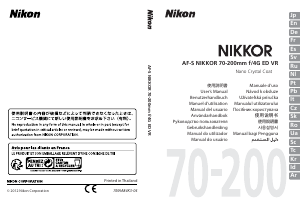
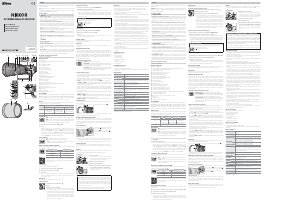
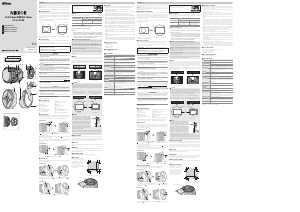
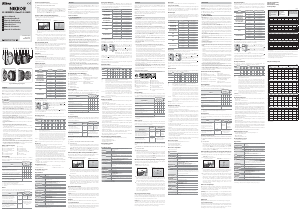
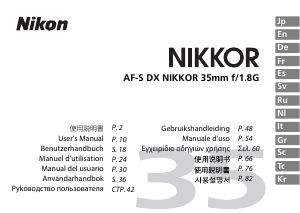
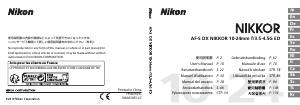
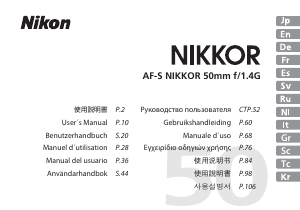
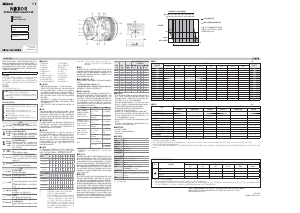
Praat mee over dit product
Laat hier weten wat jij vindt van de Nikon Nikkor AF 14mm f/2.8D ED Objectief. Als je een vraag hebt, lees dan eerst zorgvuldig de handleiding door. Een handleiding aanvragen kan via ons contactformulier.